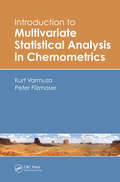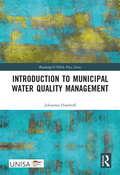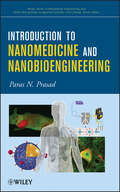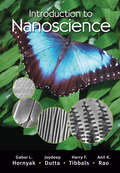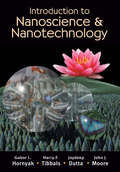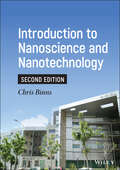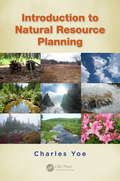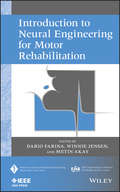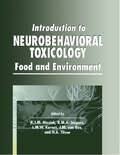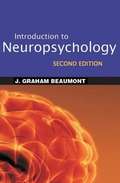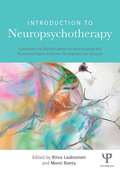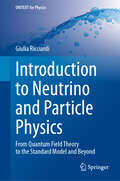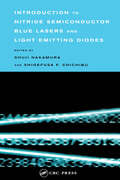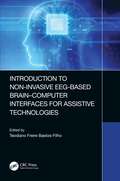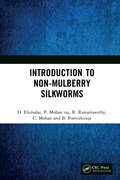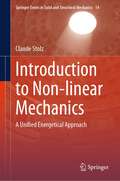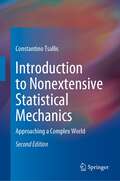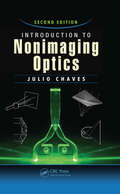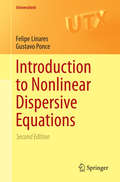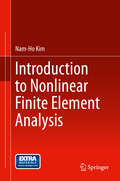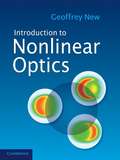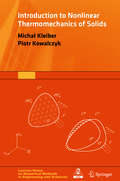- Table View
- List View
Introduction to Multivariate Statistical Analysis in Chemometrics
by Peter Filzmoser Kurt VarmuzaUsing formal descriptions, graphical illustrations, practical examples, and R software tools, Introduction to Multivariate Statistical Analysis in Chemometrics presents simple yet thorough explanations of the most important multivariate statistical methods for analyzing chemical data. It includes discussions of various statistical methods, such as
Introduction to Municipal Water Quality Management (Routledge/UNISA Press Series)
by Johannes HaarhoffThe focus of municipalities has been on the supply of sufficient water quantities to the public with less attention paid to water quality. The deteriorating quality of raw water sources necessitates increased attention to water quality with professional scientists playing a central role at municipalities and water boards together with professional engineers. With many stringent regulations on the quality of drinking water and recreational water bodies, the young municipal chemist needs a handy manual to assist in the often neglected and complicated field of municipal water management. Grounded in Science, Introduction to Municipal Water Quality Management not only links theory and regulations in practice but also offers simple numerical examples to better understand the rules and encourage a quantitative application to everyday problems. Developed from a series of lectures between 2015 and 2019, Introduction to Municipal Water Quality Management will give young professionals the confidence to analyse their results and apply their knowledge in a numerical fashion.
Introduction to Muon Spin Spectroscopy: Applications to Solid State and Material Sciences (Lecture Notes in Physics #961)
by Alex Amato Elvezio MorenzoniThis textbook serves as a comprehensive introduction to muon spin spectroscopy (µSR), offering a detailed exploration of how polarized positive muons can be employed as local probes to investigate material properties at the microscopic level. It provides a self-contained tutorial that begins by explaining the extraction of physical information from a µSR experiment and then proceeds to present illustrative examples in the fields of condensed matter physics, materials science, and nanoscience.The book focuses on major applications of µSR, including the study of magnetism, superconductivity, and semiconducting materials in both bulk and thin film samples. In addition, two chapters delve into the applications of negative muons, emphasizing their role in elemental materials analysis and introducing fundamental particle physics aspects of muon science. Supplementary material, conveniently summarized in several appendices, covers essential basic concepts.For further exploration, an extensive list of references is provided, enabling readers to deepen their knowledge in specific areas.To facilitate understanding and mastery of the subject, the textbook offers exercises and solutions. It caters to advanced undergraduate, graduate and PhD level students, researchers who intend to utilize the µSR technique or seek a comprehensive understanding of µSR results for their research, as well as to established practitioners.
Introduction to Nanomedicine and Nanobioengineering
by Paras N. PrasadThis book is an introduction to the emerging field of nanomedicine and its applications to health care. It describes the many multidisciplinary challenges facing nanomedicine and discusses the required collaboration between chemists, physicists, engineers and clinicians. The book introduces the reader to nanomedicine's vast potential to improve and extend human life through the application of nanomaterials in diagnosis and treatment of disease.
Introduction to Nanoscience
by Joydeep Dutta Gabor L. Hornyak H.F. Tibbals Anil RaoTomorrow's nanoscientist will have a truly interdisciplinary and nano-centric education, rather than, for example, a degree in chemistry with a specialization in nanoscience. For this to happen, the field needs a truly focused and dedicated textbook. This full-color masterwork is such a textbook. It introduces the nanoscale along with the societal
Introduction to Nanoscience and Nanotechnology
by John J. Moore Joydeep Dutta Gabor L. Hornyak H.F. TibbalsThe maturation of nanotechnology has revealed it to be a unique and distinct discipline rather than a specialization within a larger field. Its textbook cannot afford to be a chemistry, physics, or engineering text focused on nano. It must be an integrated, multidisciplinary, and specifically nano textbook. The archetype of the modern nano textbook
Introduction to Nanoscience and Nanotechnology (Wiley Survival Guides In Engineering And Science Ser. #6)
by Chris BinnsThe book presents nanoscience and nanotechnology to a broad audience that does not necessarily have a scientific background. This book starts with the fundamental physicochemical properties of nanoparticles and nanostructures, and discusses how these special properties can be manipulated to produce high-performance materials and devices. In the following chapters, the scope is broadened to cover naturally occurring nanoparticles and artificially-engineered carbon nanoparticles, their mechanical properties, and their importance to the rest of nanotechnology. The book also covers the two design ideologies for manufacturing nanostructures, the bottom-up and top-down methods, and discusses how these two can be combined to allow for the imaging, probing and manipulation of nanostructures. The remainder of the book surveys the current state of nanotechnology, including the use of single-nanoparticle devices in data storage, electronics, optics, and solar power; advances in nanoparticle manufacturing and biotechnology that can lead to powerful new cancer treatments; and the use of nanotechnology to study the “quantum vacuum”.
Introduction to Natural Products Chemistry
by Rensheng Xu Yang Ye Weimin ZhaoNatural products chemistry-the chemistry of metabolite products of plants, animals and microorganisms-is involved in the investigation of biological phenomena ranging from drug mechanisms to gametophytes and receptors and drug metabolism in the human body to protein and enzyme chemistry. Introduction to Natural Products Chemistry has collected the
Introduction to Natural Resource Planning
by Charles YoeThis is an exciting time for natural resources planning. There are amazing technologies available to planners and a wide and growing array of resources, problems, and opportunities that need attention. Private and public interests are taking up these issues all over the world and at all levels of involvement. At the same time, inefficient planning
Introduction to Neural Engineering for Motor Rehabilitation
by Metin Akay Winnie Jensen Dario FarinaThe only book that covers in detail a broad range of cutting-edge topics within motor rehabilitation technology Neural engineering is a discipline that uses engineering techniques to understand, repair, replace, enhance, or treat diseases of neural systems. This book describes state-of-the-art methods within this field, from brain-computer interfaces to spinal and cortical plasticity. Touching on electrode design, signal processing, the neurophysiology of movement, robotics, and much more, this innovative book presents the latest information for readers working in biomedical engineering.
Introduction to Neurobehavioral Toxicology: Food and Environment
by J.M. van Ree Rj. M. Niesink R.M.A. Jaspers Lm. W. KornetIntroduction to Neurobehavioral Toxicology: Food and Environment examines the effects of chemicals on the central and peripheral nervous system and the subsequent changes in behavior, with a focus on the toxicity of food components and behavioral effects of environmental toxicants. Topics addressed include acute and chronic effects; reversible and
Introduction to Neuropsychology, Second Edition
by Andrew Mayes J. Graham BeaumontThis outstanding text gives students a solid grounding in clinical and experimental neuropsychology. The author is a leading authority whose engaging writing style and thorough yet concise coverage of brain localization, anatomy, and their links to cognitive function make the book ideal for undergraduate or graduate use. It is illustrated with more than 60 figures, including six color plates. New to This Edition Incorporates more than two decades of major advances in the field--including developments in basic science, assessment, rehabilitation, and clinical research. Coverage of neuroimaging. Chapter on degenerative diseases and profound brain injury.
Introduction to Neuropsychotherapy: Guidelines for Rehabilitation of Neurological and Neuropsychiatric Patients Throughout the Lifespan
by Ritva Laaksonen Mervi RantaThis groundbreaking volume provides a theoretical overview and clinical guidelines for the application of neuropsychotherapy. It takes a multidisciplinary approach, combining neuropsychological knowledge with recent conceptualizations from neuroscience and psychotherapy, with special emphasis on the role of working alliance. The first part of the book focuses on the historical roots of neuropsychotherapy. Then, a framework of interpersonal process in neuropsychotherapy and conceptualization for clinical purposes are described. Resistance is described through a historical perspective of conceptualizations to the present-day demands of understanding this phenomenon in the process of neuropsychotherapy. In addition, the neuropsychology of emotions is presented in a therapeutic process through a case intervention. The latter chapters of the book are concerned with special interest interventions and psychotherapeutic working methods suited for neuropsychotherapy. Representing a wide variety of theoretical, research oriented, clinical neuropsychological and psychotherapeutic expertise, this book will interest professionals in neuropsychological rehabilitation and those working with patients with cognitive, emotional and behavioral disorders in in-patient and out-patient settings.
Introduction to Neutrino and Particle Physics: From Quantum Field Theory to the Standard Model and Beyond (UNITEXT for Physics)
by Giulia RicciardiThis textbook offers a clear and concise introduction to the main aspects of neutrino physics, providing the foundational knowledge necessary for research in both theoretical and experimental fields. It presents field theory concepts in a highly self-contained manner and explains the main experimental techniques and phenomenological aspects of neutrino and particle physics with clarity and scientific rigor. Specialized jargon and traditionally ambiguous concepts are carefully explained. The book’s didactic style focuses on a selected number of key topics, enriched with numerous figures and examples. Significant recent advancements in theory and experiments are described within their physical context, avoiding technical details likely to become outdated soon. This book will be invaluable not only for students of particle physics but also as a concise reference for researchers in other fields seeking an up-to-date understanding of essential concepts in neutrino physics.
Introduction to Nitride Semiconductor Blue Lasers and Light Emitting Diodes
by Shuji Nakamura Shigefusa F. ChichibuThe "blue laser" is an exciting new device used in physics. The potential is now being recognized for its development into a commercial lighting system using about a tenth of the power and with a thousand times the operating lifetime of a comparable conventional system. This comprehensive work introduces the subject at a level suitable for graduate
Introduction to Non-Invasive EEG-Based Brain-Computer Interfaces for Assistive Technologies
by Teodiano Freire Bastos-FilhoThis book aims to bring to the reader an overview of different applications of brain-computer interfaces (BCIs) based on more than 20 years of experience working on these interfaces. The author provides a review of the human brain and EEG signals, describing the human brain, anatomically and physiologically, with the objective of showing some of the patterns of EEG (electroencephalogram) signals used to control BCIs. It then introduces BCIs and different applications, such as a BCI based on ERD/ERS Patterns in α rhythms (used to command a robotic wheelchair with an augmentative and alternative communication (AAC) system onboard it); a BCI based on dependent-SSVEP to command the same robotic wheelchair; a BCI based on SSVEP to command a telepresence robot and its onboard AAC system; a BCI based on SSVEP to command an autonomous car; a BCI based on independent-SSVEP (using Depth-of-Field) to command the same robotic wheelchair; the use of compressive technique in SSVEP-based BCI; a BCI based on motor imagery (using different techniques) to command a robotic monocycle and a robotic exoskeleton; and the first steps to build a neurorehabilitation system based on motor imagery of pedalling together an in immersive virtual environment. This book is intended for researchers, professionals and students working on assistive technology.
Introduction to Non-Mulberry Silkworms
by D. Elumalai P. Mohan raj R. Ramamoorthy C. Mohan B. PoovizhirajaThis book will serve as a valuable source of information on the aspects of history, current scenario, non-mulberry cultivation, pruning, pests and diseases of eri, tasar and muga, silkworm rearing, pests and diseases of non-mulberry silkworm, processing of cocoon etc. This book can be used as resource material and practical guide for the students of agriculture, horticulture and sericulture. Note: T&F does not sell or distribute the Hardback in India, Pakistan, Nepal, Bhutan, Bangladesh and Sri Lanka.
Introduction to Non-linear Mechanics: A Unified Energetical Approach (Springer Series in Solid and Structural Mechanics #14)
by Claude StolzThis book presents an introduction to the non-linear mechanics of materials, focusing on a unified energetical approach. It begins by summarizing the framework of a thermodynamic description of continua, including a description of the kinematics of deformation, and a summary of the equations of motion. After a short description of the motion of the system and the mechanical interaction, the book introduces the Lagrangean and Hamiltonian functionals of the system, transitioning to the quasistatic characterization with emphasis on the role of potential energy and pseudo-potential of dissipation. The framework is then extended to fracture and damage mechanics with a similar energetical approach proposed for material damage and wear. The book looks at homogenization in non-linear mechanics for locally plastic or damaged material with an analysis of stability and bifurcation of the equilibrium path. Lastly, inverse problems in non-linear mechanics are introduced using optimal control theory. All the concepts introduced in the book are illustrated using analytical solutions on beams, rods, plates, or using spherical and cylindrical symmetries. Graduate students and researchers working on continuum mechanics and interested in a deeper understanding of materials damage, wear, and fatigue will find this book instructive and informative.
Introduction to Nonextensive Statistical Mechanics: Approaching a Complex World
by Constantino TsallisThis book focuses on nonextensive statistical mechanics, a current generalization of Boltzmann-Gibbs (BG) statistical mechanics.Conceived nearly 150 years ago by Maxwell, Boltzmann and Gibbs, the BG theory, one of the greatest monuments of contemporary physics, exhibits many impressive successes in physics, chemistry, mathematics, and computational sciences. Presently, several thousands of publications by scientists around the world have been dedicated to its nonextensive generalization. A variety of applications have emerged in complex systems and its mathematical grounding is by now well advanced.Since the first edition release thirteen years ago, there has been a vast amount of new results in the field, all of which have been incorporated in this comprehensive second edition. Heavily revised and updated with new sections and figures, the second edition remains the go-to text on the subject.A pedagogical introduction to the BG theory concepts and their generalizations – nonlinear dynamics, extensivity of the nonadditive entropy, global correlations, generalization of the standard CLT’s, complex networks, among others – is presented in this book, as well as a selection of paradigmatic applications in various sciences together with diversified experimental verifications of some of its predictions. Introduction to Nonextensive Statistical Mechanics is suitable for students and researchers with an interest in complex systems and statistical physics.
Introduction to Nonimaging Optics
by Julio ChavesIntroduction to Nonimaging Optics covers the theoretical foundations and design methods of nonimaging optics, as well as key concepts from related fields. This fully updated, revised, and expanded Second Edition: Features a new and intuitive introduction with a basic description of the advantages of nonimaging optics Adds new chapters on wavefronts for a prescribed output (irradiance or intensity), infinitesimal étendue optics (generalization of the aplanatic optics), and Köhler optics and color mixing Incorporates new material on the simultaneous multiple surface (SMS) design method in 3-D, integral invariants, and étendue 2-D Contains 21 chapters, 24 fully worked and several other examples, and 1,000+ illustrations, including photos of real devices Addresses applications ranging from solar energy concentration to illumination engineering Introduction to Nonimaging Optics, Second Edition invites newcomers to explore the growing field of nonimaging optics, while providing seasoned veterans with an extensive reference book.
Introduction to Nonlinear Circuits and Networks
by Santo Banerjee Bharathwaj MuthuswamyThis course-based text revisits classic concepts in nonlinear circuit theory from a very much introductory point of view: the presentation is completely self-contained and does not assume any prior knowledge of circuit theory. It is simply assumed that readers have taken a first-year undergraduate course in differential and integral calculus, along with an elementary physics course in classical mechanics and electrodynamics. Further, it discusses topics not typically found in standard textbooks, such as nonlinear operational amplifier circuits, nonlinear chaotic circuits and memristor networks. Each chapter includes a set of illustrative and worked examples, along with end-of-chapter exercises and lab exercises using the QUCS open-source circuit simulator. Solutions and other material are provided on the YouTube channel created for this book by the authors.
Introduction to Nonlinear Dispersive Equations
by Felipe Linares Gustavo PonceThis textbook introduces the well-posedness theory for initial-value problems of nonlinear, dispersive partial differential equations, with special focus on two key models, the Korteweg-de Vries equation and the nonlinear Schrödinger equation. A concise and self-contained treatment of background material (the Fourier transform, interpolation theory, Sobolev spaces, and the linear Schrödinger equation) prepares the reader to understand the main topics covered: the initial-value problem for the nonlinear Schrödinger equation and the generalized Korteweg-de Vries equation, properties of their solutions, and a survey of general classes of nonlinear dispersive equations of physical and mathematical significance. Each chapter ends with an expert account of recent developments and open problems, as well as exercises. The final chapter gives a detailed exposition of local well-posedness for the nonlinear Schrödinger equation, taking the reader to the forefront of recent research. The second edition of Introduction to Nonlinear Dispersive Equations builds upon the success of the first edition by the addition of updated material on the main topics, an expanded bibliography, and new exercises. Assuming only basic knowledge of complex analysis and integration theory, this book will enable graduate students and researchers to enter this actively developing field.
Introduction to Nonlinear Finite Element Analysis
by Nam-Ho KimThis book introduces the key concepts of nonlinear finite element analysis procedures. The book explains the fundamental theories of the field and provides instructions on how to apply the concepts to solving practical engineering problems. Instead of covering many nonlinear problems, the book focuses on three representative problems: nonlinear elasticity, elastoplasticity, and contact problems. The book is written independent of any particular software, but tutorials and examples using four commercial programs are included as appendices: ANSYS, NASTRAN, ABAQUS, and MATLAB. In particular, the MATLAB program includes all source codes so that students can develop their own material models, or different algorithms. Please visit the author's website for supplemental material, including PowerPoint presentations and MATLAB codes, at http://www2. mae. ufl. edu/nkim/INFEM/
Introduction to Nonlinear Optics
by Geoffrey NewSince the early days of nonlinear optics in the 1960s, the field has expanded dramatically, and is now a vast and vibrant field with countless technological applications. Providing a gentle introduction to the principles of the subject, this textbook is ideal for graduate students starting their research in this exciting area. After basic ideas have been outlined, the book offers a thorough analysis of second harmonic generation and related second-order processes, before moving on to third-order effects, the nonlinear optics of short optical pulses and coherent effects such as electromagnetically-induced transparency. A simplified treatment of high harmonic generation is presented at the end. More advanced topics, such as the linear and nonlinear optics of crystals, the tensor nature of the nonlinear coefficients and their quantum mechanical representation, are confined to specialist chapters so that readers can focus on basic principles before tackling these more difficult aspects of the subject.
Introduction to Nonlinear Thermomechanics of Solids
by Michał Kleiber Piotr KowalczykThe first part of this textbook presents the mathematical background needed to precisely describe the basic problem of continuum thermomechanics. The book then concentrates on developing governing equations for the problem dealing in turn with the kinematics of material continuum, description of the state of stress, discussion of the fundamental conservation laws of underlying physics, formulation of initial-boundary value problems and presenting weak (variational) formulations. In the final part the crucial issue of developing techniques for solving specific problems of thermomechanics is addressed. To this aim the authors present a discretized formulation of the governing equations, discuss the fundamentals of the finite element method and develop some basic algorithms for solving algebraic and ordinary differential equations typical of problems on hand. Theoretical derivations are followed by carefully prepared computational exercises and solutions.
